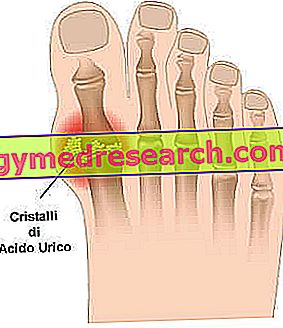Related articles: Hallux valgus
Definition
Hallux valgus is a progressive deformation of the first toe, which causes it to deviate towards the inside and the other fingers; consequently, there is also a prominence of the medial portion of the head of the 1st metatarsal bone
The deviation of the big toe shows the formation of the so-called "onion", a protuberance that indicates a painful inflammation of the corresponding mucosa bag (bursitis), which tends to worsen with the rubbing of the shoe.
The cause is often constituted by variations in the position of the 1st metatarsal bone or the big toe, secondary to rachitic, inflammatory and traumatic forms. Hallux valgus may depend on excessive rotation inside (pronation) of the ankles, hypermobility of the metatarsal joint and some neuromuscular and connective tissue diseases (eg Marfan syndrome). Risk factors include the use of shoes that force the big toe into a non-natural position and do not support the correct pronation of the foot, as in the case, for example, of shoes with a narrow toe, too small or with a high heel. Furthermore, people with congenital foot changes (eg, flat feet) are more likely to develop hallux valgus in their growing age.
Most common symptoms and signs *
- calli
- Hammer finger
- Knee pain
- Foot pain
- Articolar pains
- Edema
- Erythema
- Joint swelling
- hyperlordosis
- Joint hypermobility
- hypersplenism
- Backache
- Metatarsalgia
- onychogryphosis
- osteophytes
- Paresthesia
- Joint stiffness
Further indications
The main symptom consists in the presence of pain at the base of the big toe, which reflects an anatomical change: from the deviation of the first finger towards the second, up to changes in the alignment of the bones of the foot. At the level of the bony protuberance, on the external side of the foot, the skin shows redness, numbness and thickening that make it hard and callous (hyperkeratosis). In the advanced stages, synovitis appears, an inflammation that affects the entire joint causing a painful and hot joint swelling.
In addition to inflammation of the big toe, a functional limitation of the dynamics of the foot may appear. Over time, the disorder can develop into a true postural syndrome with tendency to knee valgus, hip stiffness and accentuation of the lumbar curve, associated with chronic low back pain. Furthermore, secondary osteoarthritis (joint degeneration) and osteophyte formation are frequent. If the hallux valgus is neglected, it tends to progressively worsen over time.
The diagnosis usually uses the baropodometric test and an X-ray, to measure the distribution of loads on the foot and the degree of impairment of the big toe.
The conservative treatment of hallux valgus uses measures to mitigate the symptoms, which however are not able to regress the deformity itself or to improve the aesthetic appearance of the foot. These measures include the use of drugs (NSAIDs, such as paracetamol and ibuprofen) to reduce pain and inflammation, and corticosteroid infiltration for bursitis or synovitis. In addition, protective pads, orthotics and custom orthoses can be used to support the foot and ankle.
If the symptoms are very severe and conservative treatments fail to provide relief, surgery can be considered. The type of operation most frequently used is called osteotomy (percutaneous or open); it involves performing some cuts on the bone in order to correct the deviation of the metatarsus. Other surgical techniques are arthrodesis and resection arthroplasty (Keller).
The best way to reduce the likelihood of developing hallux valgus is to wear shoes that fit comfortably and functionally: you need to make sure they are the right size and leave enough space to allow your toes to move freely.



